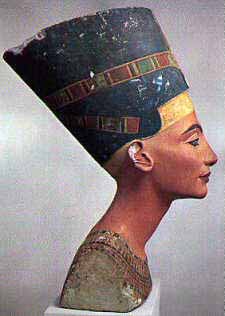

The Great Royal Wife of Pharaoh Amenhotep IV - Akhenaten
Nefertiti was the wife of the Egyptian Pharaoh Amenhotep IV (later Akhenaten), and mother-in-law of the Pharaoh Tutankhamun. Her name roughly translates to "the beautiful one is come". She also shares her name with a type of elongated gold bead that she was often portrayed as wearing, known as "nefer" beads. Famed throughout the ancient world for her outstanding beauty, Nefertiti remains the one of the most well known Queen of Egypt. Though Akhenaten had several wives, Queen Nefertiti was his chief wife.
She was made famous by her painted limestone bust (above), now in Berlin's Egyptian Museum, shown to the right. The bust, seen from two different angles, is indeed, the most famous depiction of Queen Nefertiti. Found in the workshop of the famed sculptor Thutmose, the bust is believed to be a sculptor's model. The technique which begins with a carved piece of limestone, requires the stone core to be first plastered and then richly painted. Flesh tones on the face give the bust life.
Her full lips are enhanced by a bold red. Although the crystal inlay is missing from her left eye, both eyelids and brows are outlined in black. Her graceful elongated neck balances the tall, flat-top crown which adorns her sleek head. The vibrant colors of the her necklace and crown contrast the yellow-brown of her smooth skin. While everything is sculpted to perfection, the one flaw of the piece is a broken left ear. Because this remarkable sculpture is still in existence, it is no wonder why Nefertiti remains 'The Most Beautiful Woman in the World.'
Nefertiti's origins are confusing. It has been suggested to me that Tiy was also her mother. Another suggestion is that Nefertiti was Akhenaten's cousin. Her wet nurse was the wife of the vizier Ay, who could have been Tiy's brother. Ay sometimes called himself "the God's father," suggesting that he might have been Akhenaten's father-in-law. However Ay never specifically refers to himself as the father of Nefertiti, although there are references that Nefertiti's sister, Mutnojme, is featured prominently in the decorations of the tomb of Ay. We may never know the truth of this bloodline. Perhaps they didn't know it either.
Nefertiti joined her husband in worship of this new religion that celebrated the power of the sun-disk Aten - a god of light. In this religion, she was a priest. Supposedly, It was only through the combined royal pair, that the full blessing of god Aten could be bestowed.
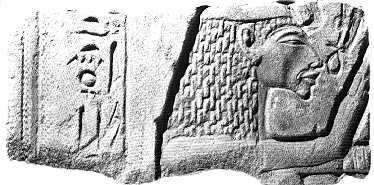
The sandstone relief above found in a temple at Karnak depicts Nefertiti praying to Aten and is characteristic of the Karnak style. Her grotesque features include an oversized ear, a protruding face, and an elongated neck and chin. This does remind one of realistic images of Akhenaten, who suffered from an illness called Marfan Syndrome, characterized by unusually long limbs.
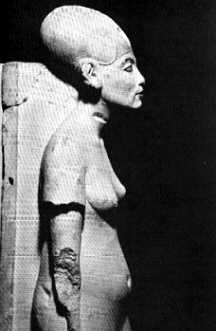
Akhenaten and Nefertiti moved the capitol of Egypt from Thebes, where it had been for centuries, north to Tell- el Amarna.
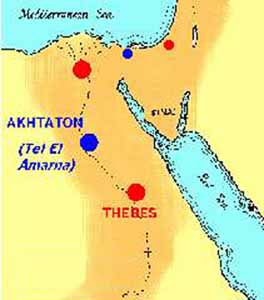
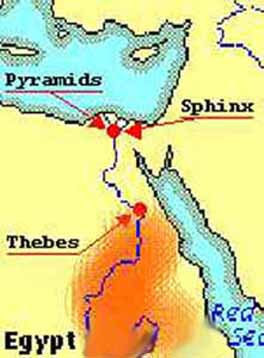
During the early years of her royal reign, Nefertiti as part of her religious conversion changed her name.
Nefertiti means 'The beautiful woman has come'.
She changed her name to 'Neferneferuaten-Nefertiti' or 'The Aten is radiant because the-beautiful one has come'.
A different interpretation of the name - 'Neferneferuaten' - 'Perfect One of the Aten's Perfection'.
Following his wife's lead, Amenhotep IV changed his name in the fifth year of his reign to Akhenaten.
Nefertiti's central role in the adpotion of this new religion is witnessed in the artistic representations which adorn temple walls.
And the Heiress, Great in the Palace, Fair of Face,
Adorned with the Double Plumes, Mistress of Happiness,
Endowed with Favours, at hearing whose voice the King rejoices,
the Chief Wife of the King, his beloved, the Lady of the Two Lands,
Neferneferuaten-Nefertiti, May she live for Ever and Always.
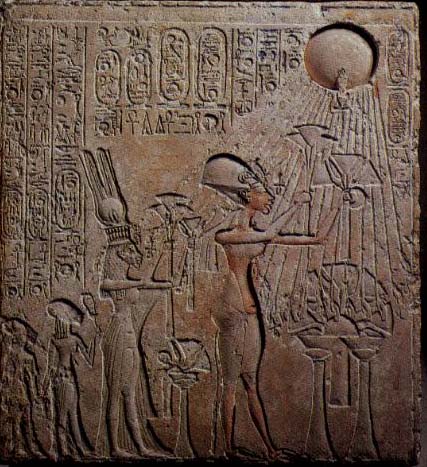
Together Akhenaten and Nefertiti transformed the religious practices of ancient Egyptian society. This limestone relief (above), found in the Royal Tomb at Amarna depicts Akhenaten, Nefertiti, and two of their six daughters making an offering to the sun-disk Aten. Akhenaten and Nefertiti carry flowers to be laid on the table beneath the "life-giving" rays of the Aten.
The figures are carved in the grotesque style, a characteristic of the early half of the Amarna period. Nefertiti, sporting the double plume headdress mentioned in the stela dedication, is the petite figure placed behind her larger scale husband. The compostion mirrors early artistic representations of the royal couple. To emphasize the strength and power of the pharaoh, Egyptian iconographical tradition required the female figure to be smaller in scale than the male.
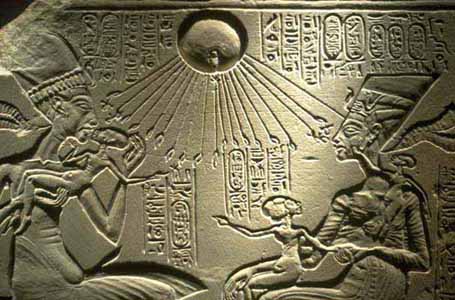
This shrine stela also from the early part of the Amarna period depicts Akhenaten, Nefertiti, and Princesses Meretaten, Mekeaten, and Ankhesenpaaten worshiping the Aten as a family. Dorothea Arnold in her article "Aspects of the Royal Female Image during the Amarna Period" discusses the plethora of reliefs depicting intimate family moments. While Akhenaten leans forward to give Meretaten a kiss, Mekeaten plays on her mother's lap and gazes up lovingly.
At the same time Ankhesenpaaten, the smallest, sits on Nefertiti's shoulder and fiddles with her earring. Arnold claims that the shrine stela "relates to the Aten religion's concept of creation" in which the King and Queen are viewed as "a primeval 'first pair." At the top of the composition, the sun-god, Aten, represented by a raised circle, extends his life-giving rays to the Royal Family. The relief uses the concept of the "window of appearances" or a snapshot of life. The figures are framed by a fictive structure which suggests the form of a square window. Aldred in his book Egyptian Art calls this "a brief moment in the lives of five beings as they are caught in an act of mutual affection". In actuality, the royal palace at Akhetaten had a window from which the royal couple could observe the city and address their subjects.
It is accepted that Akhenaten and Nefertiti had six daughters. No son was ever shown in reliefs.
The names of the daughters were; Meritaten (1349 BC) - Meketaten and Ankhenspaaten (1346 BC) - Neferneferuaten (1339 BC) - Neferneferure and Setepenre (1338).
In 1337 BC the official family, with all six of Nefertiti's daughters was shown for the last time.
In 1336 BC Meketaten died in childbirth.
In 1335 Nefertiti seemed to vanish, assumed dead.
It is possible that Akhenaten's successors Smenkhkare and Tutankhaten were his children by another royal wife called Kiya who became his principle queen for a short while after year 12 of his reign.
As with Akhenaten there is no trace of Nefertiti's mummy. Some jewelry bearing her cartouche was found outside the royal tomb at Akhetaten but there is no real evidence that she was buried there. From surviving record it seems she either fell from favor or died at around year 12 of Akhenaten's reign. In this case her burial may have been elsewhere. It is interesting to consider that the busts on this page were found in a sculptors workshop at Akhetaten. It seems that when the city was abandoned they were left behind because such was the anti Atenist feelings that no one wanted them.
It is suspected that they were murdered, but the priests of the day who wished to return to the old religion - the worship of a panteon off gods and goddesses - stone idols - things one could see physically.
Nefertiti's place as an icon in popular culture is secure: she has become a celebrity, the second most famous "Queen" of Egypt in the European imagination and influenced through photographs the changed standards of feminine beauty of the 20th century.

As Nefertiti's tomb was never completed and no mummy was ever found, the location of Nefertiti's body has long been a subject of curiosity and speculation.
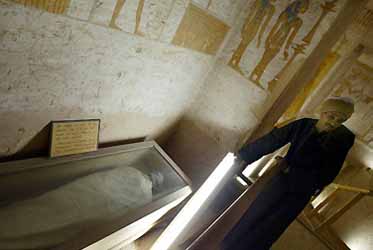
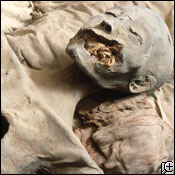
On June 9, 2003, archaeologist Joann Fletcher, a specialist in ancient hair, from the University of York in England, announced that Nefertiti's mummy may have been one found in the famous cache of mummies in tomb KV35 in Egypt's Valley of the Kings. Ms. Fletcher led an expedition, funded by the Discovery Channel, that examined what is believed to have been Nefertiti's mummy. Furthermore, it suggests that Nefertiti was in fact the Pharaoh Smenkhkare.
The mummy that was examined by the team was discovered damaged in a way that suggested the body had been desecrated either at the time of death or shortly after. Mummification techniques, such as the use of embalming fluid and the presence of an intact brain suggest an eighteenth dynasty royal mummy. Among the most suggestive features are the age of the body, the presence of embedded nefer beads, the fact that the arm had been buried in the position reserved for pharaohs and had been snapped off by vandals and replaced with another arm in a normal position, and a wig of a rare style worn by Nefertiti.
On June 12, 2003, Zahi Hawass, head of Egypt's Supreme Council for Antiquities, dismissed the claim, citing insufficient evidence.
On August 30, 2003, Reuters quoted Dr. Hawass as saying, "I'm sure that this mummy is not a female."

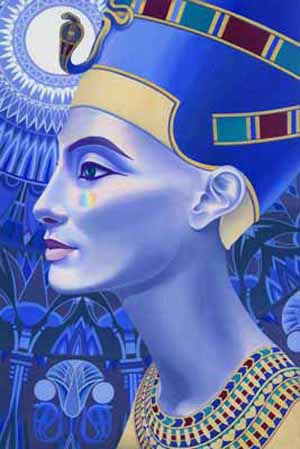
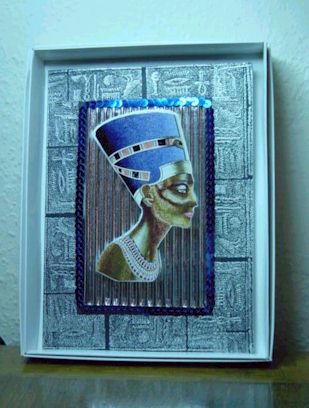
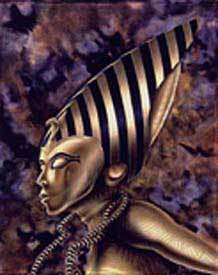
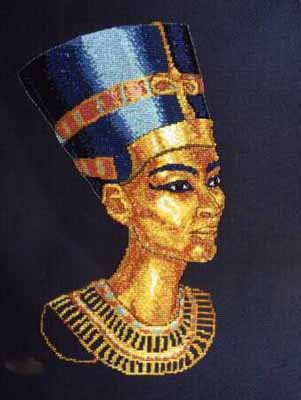
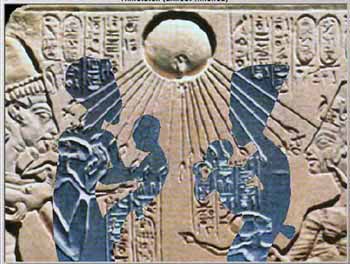
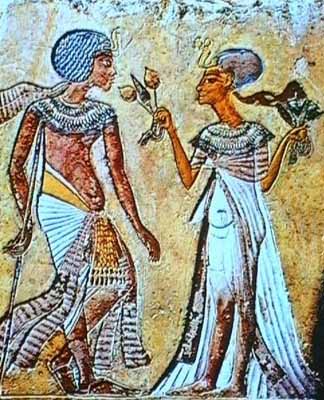
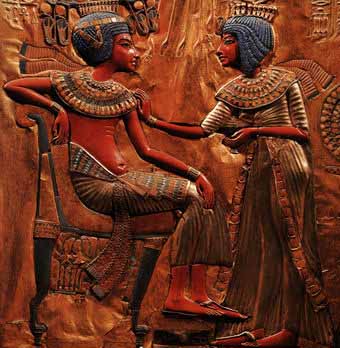
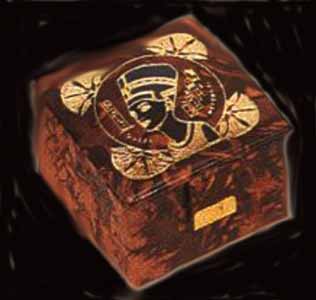
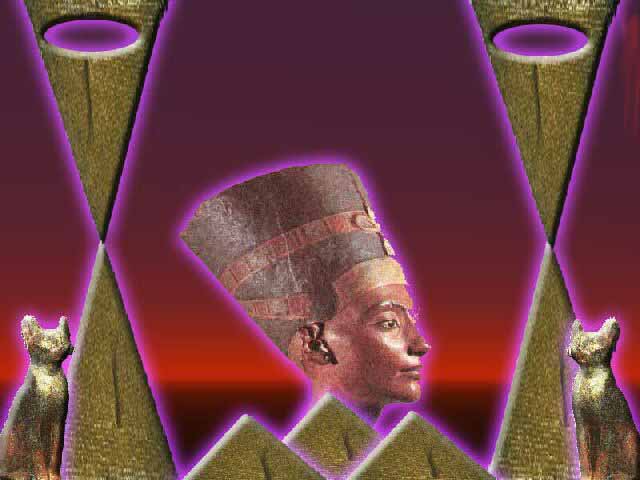





0 comments:
Post a Comment